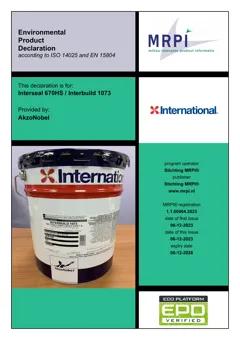

Other manufacturers with similar products
EPD: Two component surface tolerant epoxy coating, 0.344 kg/m2, Interseal 670HS / Interbuild 1073, AkzoNobel
Achieve superior protection with Interseal 670HS / Interbuild 1073, the two-component epoxy coating designed for challenging conditions. Its exceptional adhesion and durability make it ideal for industrial applications, ensuring long-lasting aesthetics and performance.
This epoxy coating offers excellent surface tolerance, high gloss finish, and durability, suitable for various surfaces. It is resistant to chemicals and UV degradation, enhancing longevity while ensuring a smooth application proce...
Manufacturer:
AkzoNobel
Group:
Country of production:
Product name:
Two component surface tolerant epoxy coating
Commercial names:
Interseal 670HS / Interbuild 1073
Category:
Coatings and pastes
Class:
Resins
Type:
PUR
Environmental impacts
Global Warming Potential (A1-A3):
0.949 kg CO2e/m²
Technical specification:
0.344 kg/m²
Available units for calculation:
m², kg, ton
Unique identifier (OCLID):
65bffc5386a96468ff2077b8
Sustainability data background information
EPD number:
1.1.00464.2023
EPD program:
MRPI
Publication year:
2023
Product Category Rules (PCR):
EN 15804:2012+A2:2019
Environmental standard:
EN15804+A2
Data source:
EPD Interseal 670HS / Interbuild 1073
Verification status:
Third-party verified (as per ISO 14025)
Upstream database:
ecoinvent



